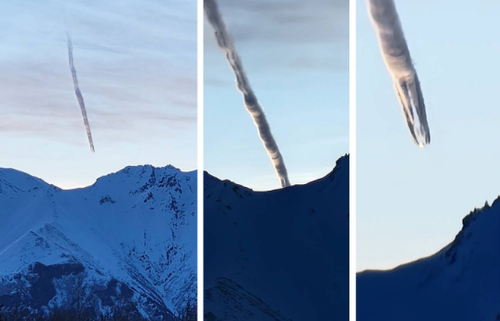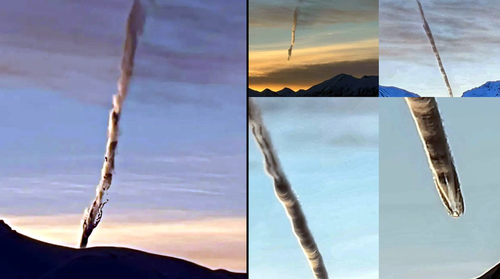You are using an out of date browser. It may not display this or other websites correctly.
You should upgrade or use an alternative browser.
You should upgrade or use an alternative browser.
Near-Earth objects and close calls
- Thread starter Gawan
- Start date
Benjamin
The Living Force
There were many reports of back-to-back meteorites on the 23rd and 24th of March in Manitoba, Canada.
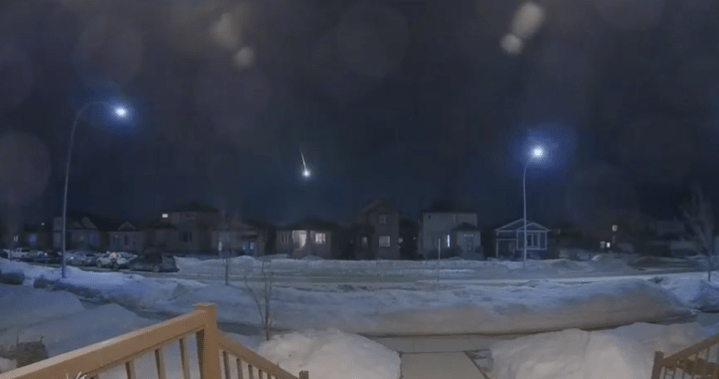
 globalnews.ca
globalnews.ca

Odds of back-to-back Manitoba meteors ‘astronomical,’ says expert - Winnipeg | Globalnews.ca
Manitoba -- as well as nearby areas -- had the extremely rare treat of seeing back-to-back meteors Tuesday and Wednesday.
These things look to getting brighter and bigger.
meteorite hits Popocatépetl volcano?
There is more information from this event
According to SkyAlert, during the early hours of this April 1, one of the monitoring cameras of the Popocatépetl volcano detected what appears to be the fall of a fireball from space, which is shown as a spectacular flash.
In the images shared by his Twitter account (@SkyAlertMx), it can be seen that the clock marks the time of 3:11 this Friday morning, while the volcano emits a small fumarole.
Suddenly in the sky on the left side of the screen you can see what looks like a fireball or a small meteorite that falls at high speed, causing a strong flash that ends up disappearing when covered by the figure of the volcano.
Within its publication, the agency pointed out that the flash was caused by the friction of the fireball when it entered the Earth's atmosphere, so it possibly ended up being destroyed. Similarly, no signs of an impact were detected
It did not hit the volcano. The fireball is hundreds of km away from where the video was taken and from perspective, it passes behind the volcano but never hits it.
FWIW - Chelyabinsk Seismic - Source
A paper on the seismic effects of the 2013 Chelyabinsk meteor explosion in the atmosphere has been published in Seismological Research Letters volume 84 number 6. Impacts with our planet cause seismic shaking, we are told. Catastrophic ground motion, even over long distances, can be generated by infrequent hypersonic collisions with large asteroids or comets. Fortunately, the atmosphere acts as a shield so that smaller objects, such as meteors, explode high in the sky – or vapourise. In most instances ground shaking is triggered by the atmospheric shock wave of a meteor exploding. Not by the impact of the bits and pieces that find their way to the surface of the earth but by the blast and shock wave. This sort of thing is best seen in the recent meteor explosion that destroyed towns and cities on the opposite bank of the Jordan river to Jericho. However, the Chelyabinsk meteor exploded too high in the atmosphere to have such an effect on the surface. Most of the energy involved was dissipated in the upper atmosphere.
A strong shock wave can be generated by explosive fragmentation – in one, or several, airbursts, as a large object is broken up in the atmosphere. On 15th February 2013 a large meteor exploded in the sky above Chelyabinsk in Russia, and produced a powerful shock wave, that caused damage to 7300 buildings. Mainly glass and superficial rather than structural damage. The fragments that landed on the surface hit the ground at subsonic terminal velocity and did not cause seismic shaking – but it was detectable. Therefore the ground shaking had another source. The shock wave produced remarkable ground motion. Seismic surface waves were observed over distances of 4000 km. Modelling indicates it was caused by the terminal airburst of the meteor. The ground shaking was dominated by Rayleigh waves. The explosion, or airburst, was manifested by the peak brightness of the flare produced, and reproduced on dash cams and surveillance cameras and videos. It took place in the stratosphere, at an altitude of 23 km above the surface. We are told that had it occurred at somewhat lower altitude its shock wave would have been much more dramatic as far as surface buildings and people were concerned. See also Tauzinetal, 2013, and Le Pichon, 2013.
It seems this paper may suggest the mechanism behind the EB, MB, and LB destruction levels endemic across the Aegean, Anatolia, the Levant and Mesopotamia at 5000 years ago, 4300 years ago, 36oo years ago, and 3200 years ago [conventional dates], as outlined by French archaeologist Claude Schaeffer in his book, ‘Stratigraphie Comparie‘ back in 1948. In those days the idea of an earthquake storm over such a wide area, even if the line of destruction followed plate boundaries, was regarded as impossible, and the book cost him his career. SIS published an article based on Schaeffer’s book, which was in French, quite a few years ago. Geoffrey Gammon was the author, a senior civil servant in the Ministry of Defence. Earthquake storms were simply regarded as impossible and Schaeffer was more or less laughed out of his position as a senior archaeologist. Amos Nur wrote an article for the proceedings of the 1997 SIS Cambridge Conference at Fitzwilliam College in Cambridge. However, the above article describes just how that can have occurred. It is an important milestone in our perception of the historical past and how catastrophism has been a feature of even the fairly recent time period. A large meteor, or a pulse of small meteors, travelling on a trajectory that passed over Iran, northern Mesopotamia, and the Levant, proceeding westwards towards the Aegean or North Africa, rupturing the ground and turning mud brick cities and towns into rubble heaps, or ruin mounds. These still litter the Near East. Some were rebuilt to live another day. Others were abandoned forever. The ground shaking excited the fault lines and plate boundaries. Might Schaeffer be vindicated, rather belatedly. You can read sections of his book at https://q-mag.org/reading-from-claude-schaeffers-stratigraphie-comparee.html … see also Amos Nur - SEG Wiki …
and see Amos Nur (Stanford) - Earthquakes and Archaeology: The Catastrophic End of the Bronze Age in 1200 BC | Department of Classics …
Chad
The Living Force
ZeroHedge
ZeroHedge - On a long enough timeline, the survival rate for everyone drops to zerowww.zerohedge.com
To save people clicking through:
"Unique Atmospheric Sight" Over Alaska Ignites Wild Social Media Speculation

by Tyler Durden
Sunday, Apr 10, 2022 - 01:00 AM
OnThursday morning, footage of a bizarre cloud formation over Alaska's Lazy Mountain sparked a tweetstorm as people searched for answers.
"The Russians?" Aliens?!" "Plane crash?" People were stunned by the vortex-like cloud posted on Twitter and across all social media platforms.
The mysterious cloud went viral, forcing the Alaska State Troopers and the Alaska Rescue Coordination Center to release a public advisory statement:
"There have been no reports of overdue aircraft or ELT activations indicating an aircraft crash.
"A rescue team on a helicopter flew a mission around the Lazy Mountain area this morning and located nothing suspicious and there were no signs of crashed aircraft," Alaska State Troopers said.
Others posted similar photos and speculated it could've been a rocket launch, a meteor, or even a volcano.
After Alaska State Troopers flew a reconnaissance mission in the area, they found nothing. Officials eventually revealed the bizarre cloud was a contrail for a commercial jet.
"Further investigation revealed that a large commercial jet was flying in that area around the time that the photos and video were taken. The aircraft was contacted and reported normal flight operations on its way to JFK airport in New York. Troopers believe that the photos and videos showed a contrail from the commercial jet combined with the rising sun which together caused the unique atmospheric sight," the statement read.
Even though officials offered their explanation, some on social media are skeptical that the crazy vortex cloud could've been something else.
Accepting that it is a contrail from a commercial jet, I wonder if the reason for the effect is an unusually cold atmosphere.
FWIW,
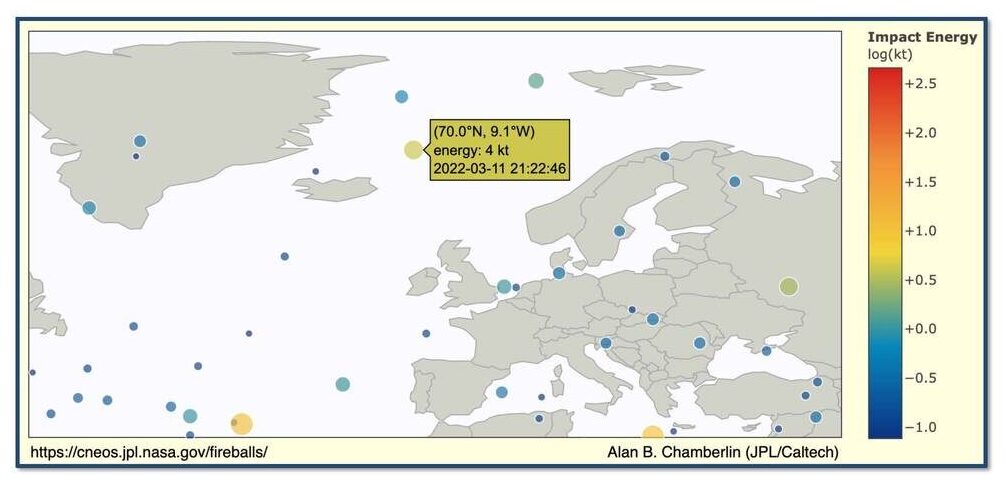
 www.sott.net
www.sott.net

Space Force releases decades of data on meteor fireballs
An agreement between NASA and the U.S. Space Force recently authorized the public release of decades of data collected by U.S. government sensors on fireball events (large bright meteors also known as bolides) for the benefit of the scientific...
I would say that this is a reasonable explanation, and if so we should see this phenomenon become a lot more common in the coming months and years. And I also suppose that the shape and form of the contrails is determined by so many factors, temperature, cleanliness of the burning of the engines, altitude, wind direction and so on... but it does look spooky!Accepting that it is a contrail from a commercial jet, I wonder if the reason for the effect is an unusually cold atmosphere.
The only reservation I would have is that whatever is at the front of it, does not look like an airplane at all, even in the zoomed in shots, but they're also rather far away shots.
Wow! Just saw by far the biggest/brightest meteor I've ever seen, while out walking.. Just before 7pm, north-east of Melbourne Australia... Big white fireball with a long tail and slight greenish bits in its large aura, whooshing down somewhere to the south-west. It looked really near but I guess it was far away, didn't hear or see anything when it came down.. That was amazing! [edit: oh it looked just like the one in sToRmR1dR's video above]
NASA teams up with the U.S. Space Force to improve the monitoring of incoming Space Rocks.
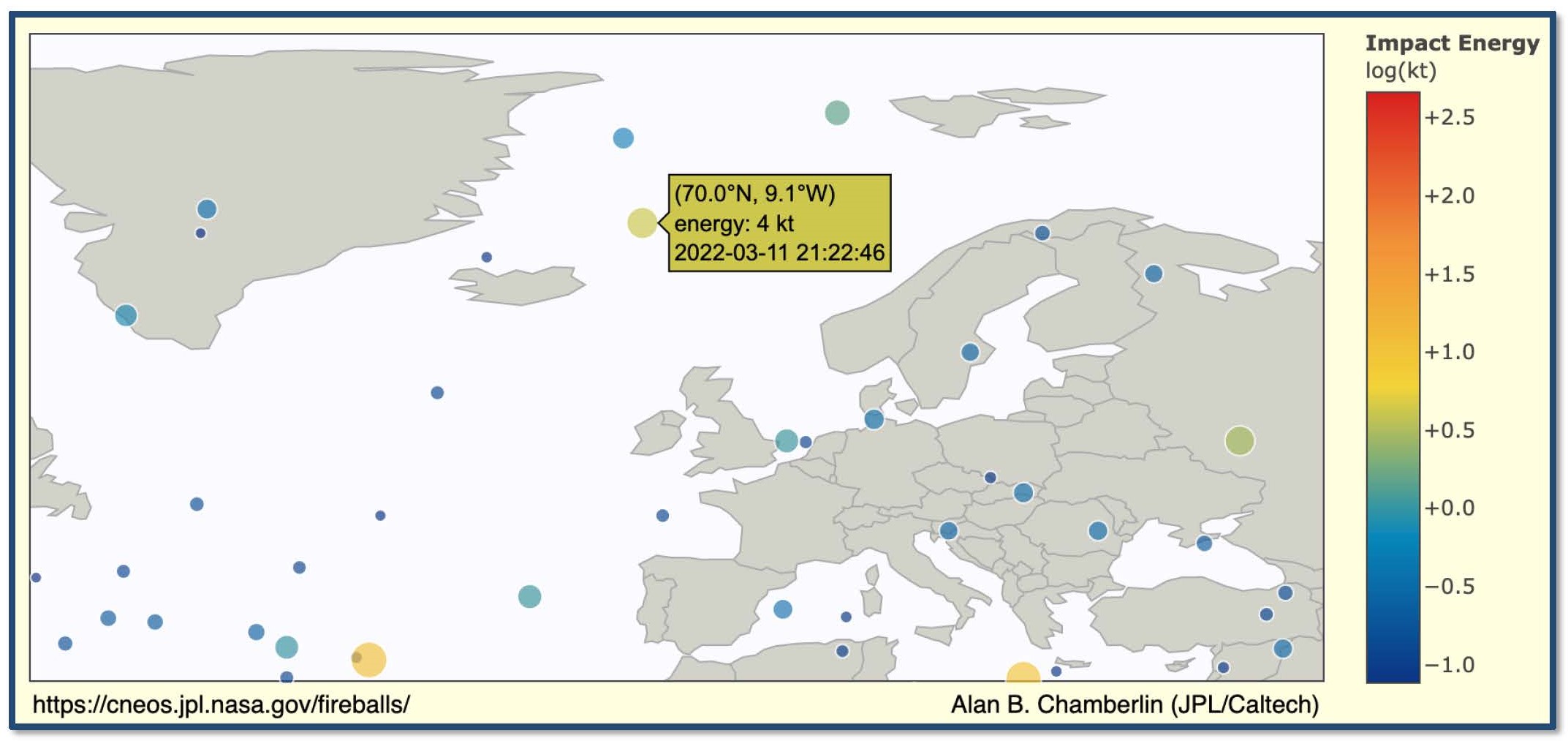
U.S. Space Force Releases Decades of Bolide Data to NASA for Planetary Defense Studies - NASA
An agreement between NASA and the U.S. Space Force recently authorized the public release of decades of data collected by U.S. government sensors on fireball
An agreement between NASA and the U.S. Space Force recently authorized the public release of decades of data collected by U.S. government sensors on fireball events (large bright meteors also known as bolides) for the benefit of the scientific and planetary defense communities. This action results from collaboration between NASA’s Planetary Defense Coordination Office (PDCO) and the U.S. Space Force to continue furthering our nation’s efforts in planetary defense, which include finding, tracking, characterizing, and cataloguing near-Earth objects (NEOs). The newly released data is comprised of information on the changing brightness of bolides as they pass through Earth’s atmosphere, called light curves, that could enhance the planetary defense community’s current ability to model the effects of impacts by larger asteroids that could one day pose a threat to Earth.
Bolides, very bright meteors that can even be seen in daylight, are a regular occurrence – on the order of several dozen times per year – that result when our planet is impacted by asteroids too small to reach the ground but large enough to explode upon impact with Earth’s atmosphere. U.S. government sensors detect these atmospheric impact events, and the bolide data is reported to the NASA Jet Propulsion Laboratory’s Center for Near Earth Object Studies (CNEOS) fireballs database, which contains data going back to 1988 for nearly one thousand bolide events. Now, planetary defense experts will have access to even more detailed data – specifically, light curve information that captures the optical intensity variation during the several seconds of an object’s breakup in the atmosphere. The data will be available to scientists as soon as it is properly archived, with the reported events and made easily accessible. This uniquely rich data set has been greatly sought after by the scientific community as an object’s breakup in Earth’s atmosphere provides scientific insight into the object’s strength and composition based on what altitudes at which it breaks up and disintegrates. The approximate total radiated energy and pre-entry velocity vector (i.e., direction) can also be better derived from bolide light curve data.
“The growing archive of bolide reports, as posted on the NASA CNEOS Fireballs website, has significantly increased scientific knowledge and contributes to the White House approved National Near-Earth Object Preparedness Strategy and Action Plan” said Lindley Johnson, planetary defense officer at NASA Headquarters. “The release of these new bolide data demonstrates another key area of collaboration between NASA and the U.S. Space Force and helps further the pursuit of improved capabilities for understanding these objects and our preparedness to respond to the impact hazard NEOs pose to Earth.”
Recently a small asteroid approximately 2 meters in size, so small it posed no hazard to Earth, was detected in space as it approached Earth and impacted the atmosphere southwest of Jan Mayen, a Norwegian island nearly 300 miles (470 kilometers) off the east coast of Greenland and northeast of Iceland. While this asteroid, designated 2022 EB5, was much smaller than objects NASA is tasked to detect and warn about, CNEOS continued to update NASA’s PDCO with impact location predictions as observations were collected leading up to 2022 EB5’s impact, offering the planetary defense community a real-word scenario to test NEO tracking capabilities and give confidence that the impact prediction process and models are adequate for timely and accurate notification of the potential impact of a larger object, should one be discovered on a trajectory toward Earth. Like other bolide events, 2022 EB5’s impact was detected by U.S. Government sensors and reported by the U.S. Space Force units, confirming the time and location predicted by CNEOS, and added to NASA's archive of these events at JPL CNEOS.
Screen capture from NASA JPL CNEOS’ Fireball webpage depicting data collected by U.S. government sensors of impact in atmosphere by small 2 meter asteroid 2022 EB5 on March 11, 2022.
Credits: NASA JPL CNEOS and U.S. Space Force's Space Operation's Center.
Another notable bolide event in this released data set is of a meteor that was detected on Jan 8, 2014. This object gained the interest of the scientific community as it has been posited it could have interstellar origin due to the detected event’s high velocity within the atmosphere. Further analysis carried out under U.S. Space Command’s purview confirmed the object’s high velocity impact, but the short duration of collected data, less than five seconds, makes it difficult to definitively determine if the object’s origin was indeed interstellar.
NASA established the PDCO in 2016 to manage the agency’s ongoing efforts in planetary defense. NASA has been directed to discover 90% of NEOs larger than 140 meters (459 feet) in size. The agency is diligently working to achieve this directive and has currently found approximately 40% of near-Earth asteroids larger than that size.
I just came across this article while doing my evening news round up, of particular interest to me was the timing of it, specially with all that has been going on since 2014, the year 0 from the C's. The link is from RT in Spanish, I will translate it below as I know that some of you might not have access to it in Europe.
U.S. Space Command confirms that in 2014 an interstellar object exploded over Earth.
Well, we've been used to learning about "close calls" with meteors and space rocks a few days or a few hours before they're to happen, now I get the sense that we will be learning about them after the fact. It is not the case in this instance, not exactly, but it seems to me that there's very expensive equipment and very prepared individuals, who will simply be unable to deal with the task as it becomes more and more overwhelming.
It is also interesting that, for now, the first interstellar space rock to explode over our atmosphere happened to do so at the beginning of 2014, months before the MH17 downing and all that such an event implied for us today. As Victor Club said, maybe we need the Cold War to disguise celestial intentions and not the other way around.
U.S. Space Command confirms that in 2014 an interstellar object exploded over Earth.
Lt. Gen. John Shaw, deputy head of U.S. Space Command. (USSPACECOM), confirmed that in 2014 an interstellar object exploded over Earth, according to a memo signed March 1 that was released Thursday of last week.
"Dr. Amir Siraj and Dr. Abraham Loeb of Harvard University's Department of Astronomy wrote a paper titled 'Discovery of a Meteorite of Interstellar Origin,'" the text reads. "This paper identified a meteor detected on 08-01-2014 at 17:05:34 UTC," it adds.
It also indicates that at the time it was reported that with 99% probability the meteor originated from an "unconsolidated hyperbolic orbit", defined as "interstellar space", detailing that the event would be three years prior to Oumuamua, a cosmic body discovered in Hawaii in 2017 that until now was considered the first known interstellar object in our solar system.
"Defending against planetary threats".
The memo explains that subsequently, Dr. Joel Mozer, chief scientist at Space Operations Command - an agency within USSPACECOM - reviewed additional data analysis on that event available from the U.S. Department of Defense.
"Dr. Mozer confirmed that the velocity estimate reported to NASA is sufficiently accurate to indicate an interstellar trajectory," concludes the text, which highlights the relationship between U.S. Space Command and the National Aeronautics and Space Administration.
During a space symposium, Shaw asserted that this confirmation "helped the astronomical community at large," stressing that U.S. Space Command can assist that community by integrating sensors and data to "detect and defend against planetary threats."
What does it look like?
In April 2019 a study submitted to The Astrophysical Journal Letters, and published on arXiv.org, claimed that a fireball that five years earlier had lit up the sky over the South Pacific could be the first meteor of interstellar origin ever detected.
Specifically, they identified an approximately 0.9-meter-wide meteor detected on January 8, 2014 at an altitude of 18.7 kilometers over a point near Manus Island in Papua New Guinea, Oceania.
Considering the high speed of the cosmic object - around 216,000 kilometers per hour - and its trajectory, at the time researchers argued that it was an interstellar object that probably arrived from the deep interior of a planetary system or a star in the disk of the Milky Way.
Well, we've been used to learning about "close calls" with meteors and space rocks a few days or a few hours before they're to happen, now I get the sense that we will be learning about them after the fact. It is not the case in this instance, not exactly, but it seems to me that there's very expensive equipment and very prepared individuals, who will simply be unable to deal with the task as it becomes more and more overwhelming.
It is also interesting that, for now, the first interstellar space rock to explode over our atmosphere happened to do so at the beginning of 2014, months before the MH17 downing and all that such an event implied for us today. As Victor Club said, maybe we need the Cold War to disguise celestial intentions and not the other way around.
Benjamin
The Living Force
An update to the 80 mile wide Comet Bernardinelli–Bernstein came out two days ago. A summery can be read at space.com. Some excerpts:
This rock is estimated to weight 500 trillion tons.
A research paper was released Apr. 12, 2022 on this comet. It's very technical and I didn't get into it. But you can find it here: Hubble Space Telescope Detection of the Nucleus of Comet C/2014 UN271 (Bernardinelli-Bernstein)

- This new behemoth of a comet was first observed in 2010.
- This comet is currently far from Earth, zooming along at about 22,000 mph (35,405 kph).
- "This is an amazing object, given how active it is when it's still so far from the sun," study lead author Man-To Hui, a researcher at the Macau University of Science and Technology, said in the same NASA statement.
- ... ALMA's radio observations allowed them to hone in on the object's reflectivity, showing that the comet's surface is darker than they expected.
"It's big, and it's blacker than coal," Jewitt said.
- This comet, being so far from Earth and originating in the farthest-flung reaches of our solar system, is thought to travel on a 3-million-year-long elliptical orbit around the sun. Scientists think that it might travel about half a light-year away from the sun in the farthest parts of its orbit.
This rock is estimated to weight 500 trillion tons.
A research paper was released Apr. 12, 2022 on this comet. It's very technical and I didn't get into it. But you can find it here: Hubble Space Telescope Detection of the Nucleus of Comet C/2014 UN271 (Bernardinelli-Bernstein)
Trending content
-
-
Thread 'Coronavirus Pandemic: Apocalypse Now! Or exaggerated scare story?'
- wanderingthomas
Replies: 30K -
Thread 'Mass Shooting at Bondi Beach, Sydney, targets Jews celebrating Hanukkah'
- Rhythmik
Replies: 100 -

